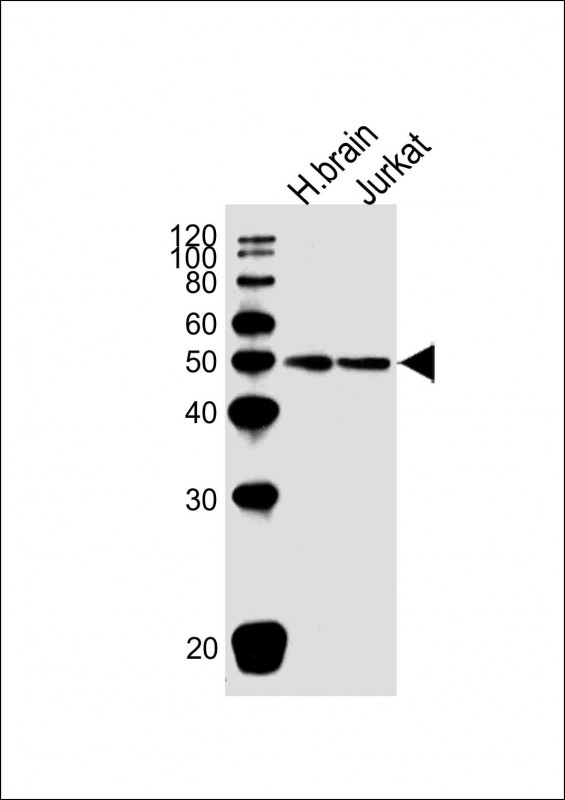CHN1 Antibody (N-term)
Affinity Purified Rabbit Polyclonal Antibody (Pab)
- SPECIFICATION
- CITATIONS
- PROTOCOLS
- BACKGROUND

Application
| WB |
|---|---|
| Primary Accession | P15882 |
| Reactivity | Human |
| Host | Rabbit |
| Clonality | Polyclonal |
| Calculated MW | H=53,50;M=53 KDa |
| Isotype | Rabbit IgG |
| Antigen Source | HUMAN |
| Gene ID | 1123 |
|---|---|
| Antigen Region | 1-30 aa |
| Other Names | N-chimaerin, A-chimaerin, Alpha-chimerin, N-chimerin, NC, Rho GTPase-activating protein 2, CHN1, ARHGAP2, CHN |
| Dilution | WB~~1:1000 |
| Target/Specificity | This CHN1 antibody is generated from rabbits immunized with a KLH conjugated synthetic peptide between 1-30 amino acids from the N-terminal region of human CHN1. |
| Storage | Maintain refrigerated at 2-8°C for up to 2 weeks. For long term storage store at -20°C in small aliquots to prevent freeze-thaw cycles. |
| Precautions | CHN1 Antibody (N-term) is for research use only and not for use in diagnostic or therapeutic procedures. |
| Name | CHN1 |
|---|---|
| Synonyms | ARHGAP2, CHN |
| Function | GTPase-activating protein for p21-rac and a phorbol ester receptor. Involved in the assembly of neuronal locomotor circuits as a direct effector of EPHA4 in axon guidance. |
| Tissue Location | In neurons in brain regions that are involved in learning and memory processes |

Thousands of laboratories across the world have published research that depended on the performance of antibodies from Abcepta to advance their research. Check out links to articles that cite our products in major peer-reviewed journals, organized by research category.
info@abcepta.com, and receive a free "I Love Antibodies" mug.
Provided below are standard protocols that you may find useful for product applications.
Background
This gene encodes GTPase-activating protein for p21-rac and a phorbol ester receptor. It plays an important role in ocular motor axon pathfinding. Heterozygous missense mutations in this gene cause Duane's retraction syndrome 2 (DURS2). Multiple transcript variants encoding different isoforms have been found for this gene.
References
Volk, A.E., et al. Graefes Arch. Clin. Exp. Ophthalmol. 248(9):1351-1357(2010)
Dick, D.M., et al. Am. J. Med. Genet. B Neuropsychiatr. Genet. 153B (6), 1179-1188 (2010) :
Rose, J.E., et al. Mol. Med. 16 (7-8), 247-253 (2010) :
Miyake, N., et al. Am. J. Med. Genet. A 152A (1), 215-217 (2010) :
Murillo-Correa, C.E., et al. J AAPOS 13(3):245-248(2009)
If you have used an Abcepta product and would like to share how it has performed, please click on the "Submit Review" button and provide the requested information. Our staff will examine and post your review and contact you if needed.
If you have any additional inquiries please email technical services at tech@abcepta.com.













 Foundational characteristics of cancer include proliferation, angiogenesis, migration, evasion of apoptosis, and cellular immortality. Find key markers for these cellular processes and antibodies to detect them.
Foundational characteristics of cancer include proliferation, angiogenesis, migration, evasion of apoptosis, and cellular immortality. Find key markers for these cellular processes and antibodies to detect them. The SUMOplot™ Analysis Program predicts and scores sumoylation sites in your protein. SUMOylation is a post-translational modification involved in various cellular processes, such as nuclear-cytosolic transport, transcriptional regulation, apoptosis, protein stability, response to stress, and progression through the cell cycle.
The SUMOplot™ Analysis Program predicts and scores sumoylation sites in your protein. SUMOylation is a post-translational modification involved in various cellular processes, such as nuclear-cytosolic transport, transcriptional regulation, apoptosis, protein stability, response to stress, and progression through the cell cycle. The Autophagy Receptor Motif Plotter predicts and scores autophagy receptor binding sites in your protein. Identifying proteins connected to this pathway is critical to understanding the role of autophagy in physiological as well as pathological processes such as development, differentiation, neurodegenerative diseases, stress, infection, and cancer.
The Autophagy Receptor Motif Plotter predicts and scores autophagy receptor binding sites in your protein. Identifying proteins connected to this pathway is critical to understanding the role of autophagy in physiological as well as pathological processes such as development, differentiation, neurodegenerative diseases, stress, infection, and cancer.


